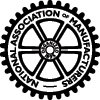The National Association of Manufacturers (NAM), the leading US business organization in the earlier part of the 20th century, was one of the first general business coalitions to take advantage of the new public relations methods and use them to gain political power.
 NAM had been formed in 1895 to promote foreign trade but in 1903 it shifted its focus to opposing labour unions and defending the right of employers to establish work conditions, fire employees at will, and set wages without interference from unions or government. It was opposed to any government intervention in the management of business. It lobbied against government legislation that aimed to help workers; disseminated anti-union propaganda; and sought to influence the outcomes of local elections to prevent pro-labour candidates being elected.
NAM had been formed in 1895 to promote foreign trade but in 1903 it shifted its focus to opposing labour unions and defending the right of employers to establish work conditions, fire employees at will, and set wages without interference from unions or government. It was opposed to any government intervention in the management of business. It lobbied against government legislation that aimed to help workers; disseminated anti-union propaganda; and sought to influence the outcomes of local elections to prevent pro-labour candidates being elected.
In 1913 NAM was investigated by a committee of Congress for mass dissemination of propaganda and paying ‘Congressmen to promote its legislative agenda’. The Inquiry report stopped just short of accusing the NAM of conspiracy:
"The correspondence between officials and employees of the association laid before your committee and placed in evidence shows it to have been an organization having purposes and aspirations along industrial, commercial, legislative, and other lines so vast and far-reaching as to excite at once admiration and fear—admiration for the genius which conceived them, and fear for the ultimate effects which the successful accomplishments of all these ambitions might have on a government such as ours."
 In 1932, when public confidence in capitalism was at an all time low and Roosevelt was threatening to regulate corporations and curb their power, big business took over the NAM to utilize it as a vehicle for pro-business propaganda. They restructured it to ensure that large corporations were well represented on the directorate. NAM claimed the right to call itself ‘the voice of American industry’ because it represented 35,000 manufacturers, employing some 5 million people.
In 1932, when public confidence in capitalism was at an all time low and Roosevelt was threatening to regulate corporations and curb their power, big business took over the NAM to utilize it as a vehicle for pro-business propaganda. They restructured it to ensure that large corporations were well represented on the directorate. NAM claimed the right to call itself ‘the voice of American industry’ because it represented 35,000 manufacturers, employing some 5 million people.
Wright Mills has clearly described the role of NAM, and associations like it that represent the top corporations, as associations which unify the managerial elite and corporate rich:
They translate narrow economic powers into industry-wide and class-wide powers; and they use these powers, first on the economic front, for example with reference to labor and its organizations; and, second, on the political front, for example in their role in the political sphere. And they infuse into the ranks of smaller businessmen the views of big business.
![]() Today NAM still claims to be "the leading advocate of a pro-growth, pro-manufacturing agenda" which reinforces "the legilsative and regulatory activities of its member firms".
Today NAM still claims to be "the leading advocate of a pro-growth, pro-manufacturing agenda" which reinforces "the legilsative and regulatory activities of its member firms".
NAM claims to represent small and medium-sized manufacturers as well as large ones. It states:
The Small & Medium Manufacturers (SMM) Department is charged with the representation of the NAM’s small to medium-sized manufacturing members before Congress, the Administration and numerous federal agencies. A primary function is to integrate the small and medium manufacturing members into the policy process from the inception of NAM legislative positions to the lobbying for those positions.